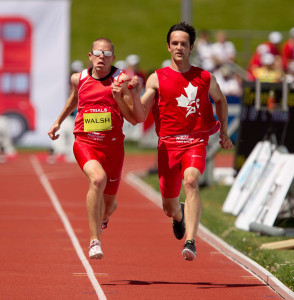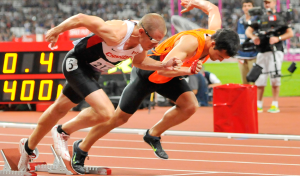Dustin Walsh, shown in competition in the photos above, is the sole author of the article on athletics and tactile graphics posted below.
Dustin is a Canadian Paralympic athlete. Here is a brief profile copied directly from the Canadian Paralympics webpage, where you can read more about Dustin: http://paralympic.ca/dustin-walsh
Growing up in Coquitlam B.C., Dustin Walsh participated in many sports, including athletics, cycling, and downhill skiing. After competing in the T11 400M at the 1997 Canada Summer Games, Walsh chose to focus on athletics, and joined a training group coached by Don Steen. Over the next 10 years, Steen coached Walsh to two Paralympic games, including a fifth place finish in the Athens 2004 400M, and the 2006 IPC World Championships, where he achieved a fourth place finish in the 400m. Since 2011, Walsh has been coached by Laurier Primeau, and in that time he has been a member of the 2012 Paralympic team, and the 2013 IPC World Championships. He has also lowered his Canadian record in the T11 400m to 53.00 seconds.
Here is his article:
Tactile Graphics for Athletic Training and Coaching, by Dustin Walsh
When you stop to consider what might be among the most common pieces of corrective advice a track and field coach would offer his athletes what do you think of? For those with a background in the sport, instructions such as higher knee drive or run tall may come immediately to mind. Others less familiar with the sport might expect motivational comments such as run hard or finish strong to be more popular. As a completely blind athlete training for the 400 meter sprint, I can confidently say that although these are all good candidates, the most common and consistent correction I hear from my coach is: chin down.
Many factors play a role in achieving efficient running mechanics, and while they are all important, having proper head position is critical. For this reason, sprinters are told to focus on a specific point at a fixed distance down the track, usually ten to fifteen meters ahead of them. This focus sets the head position and subsequently sets the neck and back into a neutral stance which allows for maximal lung capacity and the most efficient application of force into the track. For most athletes, simply setting their gaze at a fixed distance ahead of themselves creates a near optimal running posture without requiring them to worry about all the components which make up that posture. For athletes with significant vision loss however, this is not an option. Unless the proper positions are intentionally taught, and consistently reinforced, athletes like myself end up running with whatever posture feels natural, allowing any weaknesses or inflexibilities to dictate body position. Not only does this negatively impact performance, it puts the athlete at a much higher risk of long-term injury.
How then, given all its complexities, do we teach ideal posture to blind sprinters? The most common way is through hands on learning, having a coach manually manipulate the athlete’s head, shoulders, and torso. If done before a training session, this technique can be very effective throughout that session. Unfortunately, movement patterns and muscle memory take much more than a single intervention to modify. It can take many weeks if not months to affect small changes, and if those changes aren’t constantly monitored and reinforced, it is extremely likely that old habits will take over and undo hours of work. As athletes frequently travel to competitions without their personal coaches how can we ensure these hard learned positions aren’t forgotten at the worst possible time? Through the use of tactile graphics. Having graphical representations of a sprinter in optimal running form throughout each stage of a race dramatically decreases the amount of time a blind athlete needs to master the technique. This in turn allows the time spent on the track to be used in much more conventional and productive ways. Additionally, when such graphical representations are readily available, an athlete is able to review them as soon as any drop in technical quality occurs. Knowing that such a reference is literally at their fingertips whenever they need it gives athletes the peace of mind they need to excel in any training or competitive environment.
If an athlete is struggling to learn a particular skill or movement, they can sketch what they imagine the movement is supposed to look like. This gives the athlete’s coach an opportunity to understand what the athlete believes they are trying to achieve, and how that differs from what the coach is trying to communicate. The ability to directly pinpoint this miscommunication is an exceptionally powerful tool. It can enable an athlete with truly world class potential to fully realize their capabilities and achieve excellence which may not have been available to them otherwise.
This is just one example of how tactile graphics and sketching can be a great asset in one specific sport, but it demonstrates how communicating information graphically rather than verbally can enhance physical skill development for people with vision loss, and open doors to the sporting community once closed to them. Whether a student trying to succeed in a physical education class, a weekend warrior seeking greater access to recreation activities, or a gifted athlete striving for excellence at the highest levels of international sport, tools like the Intact Sketchpad can play a key roll in making these dreams into reality, and raise the bar of what is possible.



In my discussions with Dustin about sports, it occurred to me that communicating through tactile freehand drawing could be useful in interactions with health care practitioners; e.g., physical therapists, surgeons, chiropractors, masseuses, orthopedists, internists – anything where pictorial information regarding anatomy, physiology, or human movements could be worth a thousand words.